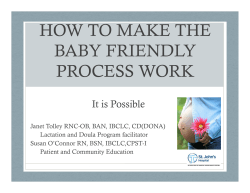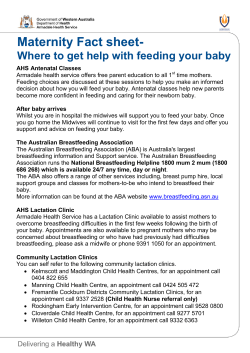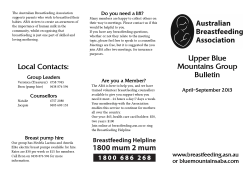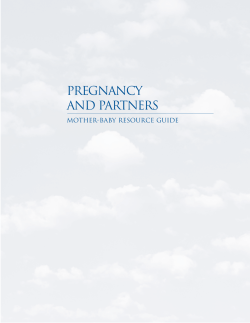
Child Malnutrition CHILD SAFETY, PEACE AND HEALTH PROMOTION THE IMPORTANCE OF NUTRITION
N O I AT T RM EE O F SH CHILD SAFETY, PEACE AND HEALTH PROMOTION Child Malnutrition IN Ghouwa Ismail & Shahnaaz Suffla March 2013 Malnutrition has become an urgent global health issue, with undernutrition killing or disabling millions of children each year. Malnutrition also prevents millions more from reaching their full intellectual and productive potential. In children, severe malnutrition accounts for approximately 1 million deaths annually1, with approximately 20 million children under the age of five suffering from severe malnutrition. In 2010, 7.6 million children across the world died before reaching their fifth birthday, while in 2011 an estimated 165 million children under the age of five were stunted (low height for age) and 101 million were underweight2. Malnutrition causes children to be more susceptible to illness, and results in long-term effects on children’s development and health. Despite the marked improvement worldwide in the prevalence of stunting and undernutrition among children under five years of age, recent South African studies indicate that child malnutrition rates have increased, thereby compromising child health. Underweight remains one of the country’s most common nutritional disorders, affecting almost 1 out of every 10 South African children3, 4. What is Malnutrition? It is a broad term commonly used as an alternative to undernutrition, but technically it also refers to overnutrition. People are malnourished if their diet does not provide adequate nutrients for growth and maintenance or they are unable to fully utilise the food they eat due to illness (undernutrition). They are also malnourished if they consume too many calories (overnutrition). What is Undernutrition? It is the outcome of insufficient food intake, inadequate care and infectious diseases. It includes being underweight for one’s age, too short for one’s age (stunting), dangerously thin for one’s height (wasting) and deficient in vitamins and minerals (micronutrient deficiencies). THE IMPORTANCE OF NUTRITION Every child develops and grows at her/his own pace and in her/his own time through reaching the various developmental milestones. Children’s growth and development do not occur in a linear fashion, but are influenced by each child’s environment, nutrition and parental care. These factors play a critical role in a child reaching her/his full potential. Recent evidence indicates that good nutrition, particularly in early childhood, is critical to the positive health outcomes of children. In fact, children’s nutritional status can be viewed as a good proxy indicator of a community’s state of health. The nutritional status of a child is usually described in terms of anthropometry, i.e. body measurement, such as weight, in relation to age or height, which is reflective of the degree of underweight or wasting of that child. Critical Window of Opportunity to Prevent Undernutrition The period from pregnancy to 2 years of age provides a crucial window of opportunity to moderate undernutrition and its adverse effects. It is during this time that proven nutrition interventions can offer children the best chance to survive and reach optimal growth, health and development. Sufficient nutrition in early childhood is critical in maintaining healthy growth, proper organ formation and functioning, a strong immune system, and neurological and cognitive development in children. Children who are undernourished, not optimally breastfed, or suffering from micronutrient deficiencies have substantially lower chances of survival than children who are well nourished. They are much more likely to suffer from a serious infection and to die from common childhood illnesses such as diarrhoea, measles, pneumonia and malaria, as well as HIV and AIDS6. Overwhelming scientific evidence supports the integral role of breastfeeding in the survival, growth and development of a child. According to the WHO, breastmilk has the complete nutritional requirements that a baby needs for healthy growth and development in the first six months of life. According to the United Nations Children’s Fund (UNICEF), children who are breastfed in the first six months of life have a six times greater chance of survival as opposed to non-breastfed children6. Evidence also indicates that breastfeeding could lead to a 13% reduction in deaths of children under five, if infants are exclusively breastfed for six months and continue to be breastfed for up to one year7. Breastmilk contains the antibodies that help strengthen a baby’s immune system, providing protection against common illnesses such as diarrhoea and pneumonia8. Consequently, breastfeeding contributes to reduced infant morbidity and mortality due to diarrhoea, respiratory or ear infections and other infectious diseases. IN FO SH RM EE AT T ION For this reason, the WHO encourages the exclusive breastfeeding of infants in the REFERENCES first six months of their life in order to achieve optimal growth, development and health. Thereafter, it is recommended that infants receive nutritionally adequate and 1. Trehan, I., Goldbach, H. S., LaGrone, L. N., Meuli, G. J., Wang, R. J., Maleta, K. M., & Manary, M. J. (2013). Antibiotics as part of the management of safe complementary solid foods, while continuing to breastfeed for up to two years severe acute malnutrition. The New England Journal of Medicine, 368, 4259 or more . This is when the child’s immune system is fully developed. 435. 2. United Nations Children’s Fund, World Health Organization, The World Since South Africa is plagued with high levels of poverty, low access to clean water, Bank. (2012). UNICEF-WHO-World Bank joint child malnutrition estimates. and inadequate sanitation, and is characterised by a high burden of disease, the New York: UNICEF; Geneva: WHO; Washington, DC: The World Bank. promotion and acceptance of optimal breastfeeding practices, such as exclusive 3. Liu, L., Johnson, H. L., Cousens, S., Perin, J., Scott, S., Lawn, J.E., et al. breastfeeding, are of vital importance. (2012). Global, regional, and national causes of child mortality: An updated systematic analysis for 2010 with time trends since 2000. Lancet, 379 (9832), 2151–2161. 4. Labadarios, D., Swart, R., Maunder, E.M.W., Kruger, H.S., Gericke, G.J., What is Exclusive Breastfeeding? Kuzwayo, P.M.N., et al. 2008. Executive summary of the National Food Consumption Survey Fortification Baseline (NFCS-FB-I) South Africa. Exclusive breastfeeding refers to providing a baby (less than six months old) South African Journal of Clinical Nutrition, 21(2), 245-300. with only breast milk and no supplementary feeding of any kind, in other 5. Dewey, K. (2003) Guiding principles for complementary feeding of the words no water, juice, other kinds of milk and solid food except for vitamins, breastfed child. WHO/Pan American Health Organisation. Available online: minerals, and medications prescribed by a doctor or healthcare worker when http://www.paho.org/ENGLISH/AD/FCH/Guiding_Principles_CF.htm 8 medically indicated . 6. United Nations Children’s Fund. (2009). Tracking progress on child and maternal nutrition: A survival and development priority. New York: UNICEF. 7. Jones, G., Steketee, R. W., Black, R. E., Bhutta, Z. A., Morris, S. S., & the Bellagio Child Survival Study Group. (2003). How many child deaths can we prevent this year? Lancet, 362, 65-71. 8. Department of Health. (2012). Breastfeeding: Frequently asked questions. Pretoria, South Africa: Department of Health. Available online: http://www. doh.gov.za/docs/publicity/2012/breastfeedingqa.pdf ACHIEVING NUTRITION REQUIREMENTS 9. Bourne, L. T. (2007). South African paediatric food-based dietary guidelines. The South African paediatric food-based dietary guidelines (FBGD) for children Maternal and Child Nutrition, 3, 227–229. younger than 7 years was developed as a nutritional education tool to facilitate the education of carers of young children in the adoption of healthy eating practices. The CONTACTS DETAILS: following is an overview of the FBGD for children younger than seven years9: 0 – 6 months • Enjoy time with your baby • Breastfeeding is best for your baby for the first 6 months • Clean your baby’s mouth regularly • Take your baby to the clinic regularly MRC-UNISA Safety & Peace Promotion Research Unit P.O. Box 19070, Tygerberg, 7505, South Africa Tel: +27 21 938 0534 | Fax: +27 21 938 0381 Email: Ghouwa.Ismail@mrc.ac.za / Annelise.Krige@mrc.ac.za Website: http://www.mrc.ac.za/crime/crime.htm 6 – 12 months • Enjoy time with your baby • From 6 months start giving your baby small amounts of solid foods • Increase your baby’s meals to 5 times a day • Continue breast-feeding your baby • Offer your baby clean safe water regularly • Teach your baby to drink from a cup • Take your baby to the clinic every month Institute for Social & Health Sciences, University of South Africa P.O. Box 1087, Lenasia, 1820, South Africa Tel: +27 87 944 7180 | Fax: +27 11 857 1770 Email: lourilc@unisa.ac.za Website: http://www.unisa.ac.za/ishs 1 – 7 years • Encourage children to eat a variety of foods • Feed children five small meals a day • Make starchy foods the basis of a child’s main meals • Children need plenty of vegetables and fruit every day • Children need to drink milk every day • Children can eat chicken, fish, meat, eggs, beans, soya or peanut butter every day • If children have sweet treats or drinks, offer small amounts with meals • Offer children clean, safe water regularly • Take children to the clinic every 3 months • Encourage children to play and be active
© Copyright 2025





















